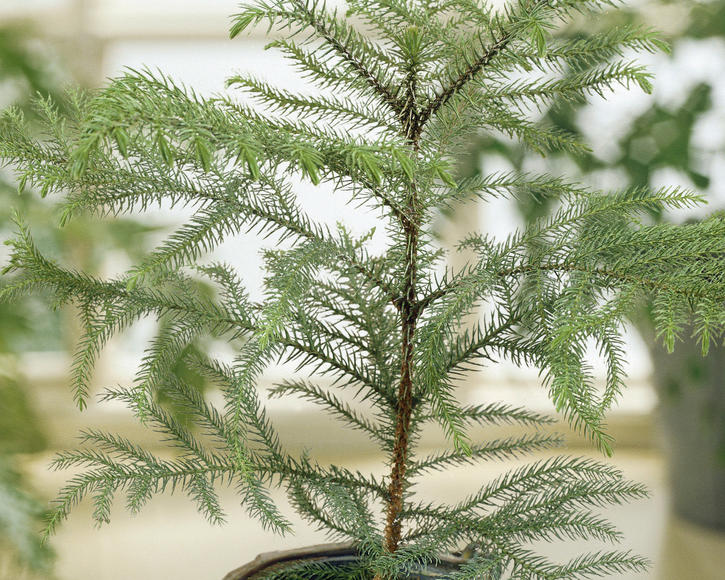Norfolk Island Pine
Norfolk Island pine brightens up our homes as a small coniferous tree in a pot. Here are some tips and tricks for how to plant and care for this houseplant.
Factsheet
- Growth type
-
- Conifer
- Growth height (from)
- from 120 cm to 200 cm
- Growth width (from)
- from 70 cm to 120 cm
- Growth characteristics
-
- conical
- sweeping
- upright
- Flower color
-
- red
- brown
- Flowering time (month)
-
- April to May
- Flower shape
-
- Cones
- Leaf color
-
- green
- page format
-
- needle-shaped
- duster
- Sheet properties
-
- evergreen
- Fruit color
-
- brown
- Fruit shape
-
- Cone
- Light
-
- scattered light
- Soil type
-
- sandy to loamy
- Soil Moisture
-
- fresh to moderately humid
- ph value
-
- neutral to weakly acidic
- Lime compatibility
-
- sensitive to lime
- Nutrient requirements
-
- moderately nutritious
- Humus
-
- rich in humus
- Decorative or utility value
-
- picturesque growth
- Winter Hardness
-
- frost-sensitive
- Use
-
- Interior greening
- Planters
- Winter garden
- cold house
- Garden style
-
- Pot garden
The Norfolk Island pine (Araucaria heterophylla) is a decorative houseplant of the genus Araucaria. Norfolk Island pine is native to Norfolk Island, situated to the east of Australia. Norfolk Island pine is closely related to the monkey puzzle tree (Araucaria araucana), which is native to South America, but is much more sensitive to frost.
The evergreen, cylindrical coniferous tree has a continuous central shoot and horizontal or slightly oblique branches. The tree reaches heights of up to 200 feet in nature, while Norfolk Island pine – depending on the pot size and location – grows between three and seven feet tall as a potted plant.
The branches on the boughs of the gray-brown scaled bark have a frond-like arrangement with soft, needle-like leaves. While young shoots are light green, the older shoots turn dark green and do not overlap.

The male cones of Araucaria heterophylla are a lot smaller than the female cones. However, they generally do not appear on houseplants.
Norfolk Island pine needs a bright but not too sunny location. It should not be put in dark corners of rooms where it will grow inconsistently. A free-standing location with good light, such as in a conservatory, encourages symmetrical crown development, and the plant also looks fantastic on its own. Norfolk Island pine also thrives in sheltered spots outdoors with partial shade during the summer months. Indoor temperatures of around 65 to 68 degrees Fahrenheit are ideal, e.g. rooms that are only occasionally heated or cool conservatories. Very warm rooms with dry air are unsuitable. Norfolk Island pine should be kept in a cool, bright location in winter. It is best to move the plant to a bright, unheated room with an air temperature of 41 to 50 degrees Fahrenheit.
Norfolk Island pine thrives in a slightly acidic, loose, humus-rich substrate with a high sand content. You can use regular rhododendron soils which are enriched with sand and clay granulate.
Keep your Norfolk Island pine moderately moist in spring, summer, and fall using water with a low lime content. You should water Araucaria heterophylla more sparingly in winter. It is best to water the plant with rainwater. Norfolk Island pine also likes to be sprayed with water on a regular basis. You should avoid waterlogging at all costs: Otherwise the container plant will lose its needles very quickly.
You should fertilize Norfolk Island pine with a liquid fertilizer every two weeks in spring and summer. Products suitable for rhododendrons and hydrangeas are ideal, as they are reliably lime-free. The tree does not generally need any nutrients in cool locations between November and February. If the Norfolk Island pine is in a warmer place, you should continue to fertilize it every four to six weeks at a slightly lower concentration.
Repot your Norfolk Island pine every three to four years in spring by moving it into a slight larger pot. As a rule of thumb, when the old root ball is placed in the new pot, there should be an “air” gap of two fingers width on both sides.

The Norfolk Island pine can and should go without pruning. You can trim any side shoots that are too long, if absolutely necessary. But make sure to cut back the shoots of each whorled branch evenly so that the crown is not lopsided.
Hobby gardeners tend to find Norfolk Island pine very difficult to propagate. The best way to do this is by sowing seeds, however it’s not that easy to get hold of them. You may be able to pick them up while on vacation, as Norfolk Island pines are planted on the Canary Islands and throughout nearly all of the Mediterranean region as garden trees. However, you should check the legal regulations before exporting. Since Araucaria heterophylla seeds quickly lose their ability to germinate, you should sow them as soon as you get them. The seeds germinate at a soil temperature of around 65 to 68 degrees Fahrenheit.
Vegetative propagation by terminal cuttings is another option, but this is also very difficult and long-winded. You should only use shoot tips for cuttings, as they retain the typical growth habit. The cuttings needs high temperatures between 77 and 86 degrees Fahrenheit to form roots. Most of the Norfolk Island pines available in stores are now obtained from meristem culture, a complex propagation process that takes place under sterile conditions in a lab.
Norfolk Island pines are occasionally infested by mealybugs, especially in fall and winter. Thrips are typical summer pests. If the tree is too warm in winter, this can cause brown needles and drooping fronds, while waterlogging often leads to root rot.

